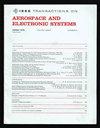不完全阵形信息下定向天线均匀弧阵的方位估计
IF 5.7
2区 计算机科学
Q1 ENGINEERING, AEROSPACE
IEEE Transactions on Aerospace and Electronic Systems
Pub Date : 2025-02-13
DOI:10.1109/TAES.2025.3541159
引用次数: 0
摘要
在基于定向天线单元的均匀电弧阵列(DA-UAA)中,由于阵列各单元的辐射方向图和极化特性信息不完全,无法利用多信号分类等传统的空间频谱估计算法求出入射电磁波的到达方向(DOA)。本文提出了一组不完全DA-UAA流形信息情况下的DOA估计算法。首先,分析了DA-UAA的接收信号模型,提出了一种结合去嵌入均衡滤波的阵列接收机主动校准方法,以解决信道间幅度和相位不一致的问题。在传统全向比幅DOA估计方法的基础上,DA-UAA采用基于余弦级数展开的多天线比幅DOA估计方法。其次,结合计算复杂度和测向精度,提出了基于低阶Legendre多项式的差和比幅DOA估计算法和基于Legendre序列的寻根比幅DOA估计方法;第三,设计了一种基于特征子空间投影的逐次抑制比幅DOA估计策略,以处理同频率的多个入射波。最后,通过数值模拟和现场实验验证了所提算法的有效性和准确性,并对cram本文章由计算机程序翻译,如有差异,请以英文原文为准。
DOA Estimation for Directional Antenna Based Uniform Arc Array With Incomplete Array Manifold Information
In the directional antenna element-based uniform arc array (DA-UAA), the conventional spatial spectrum estimation algorithms such as multiple signal classification could not be utilized to find the direction-of-arrival (DOA) of an incident electromagnetic wave because of the incomplete information about the radiation pattern and polarization characteristics of each array element. In this article, a collection of DOA estimation algorithms for cases with incomplete DA-UAA manifold information is proposed. First, the received signal model of the DA-UAA is analyzed, and an active calibration method for array receivers, incorporating de-embedding equalization filtering to address the interchannel amplitude and phase inconsistencies, is proposed. Based on the traditional omni-directional amplitude-comparison DOA estimation method, the cosine-series expansion-based multiantenna amplitude-comparison DOA estimation method is adopted by the DA-UAA. Second, the low-order Legendre polynomial-based difference-sum amplitude-comparison DOA estimation algorithm and the Legendre-series-based root-seeking amplitude-comparison DOA estimation method are proposed to combine computational complexity and direction-finding accuracy. Third, an eigen subspace projection-based successive suppression amplitude-comparison DOA estimation strategy is designed to handle multiple incident waves with the same frequency. Finally, the effectiveness and accuracy of these proposed algorithms are verified through numerical simulations and field experiments, with the Cramér-Rao Lower Bound analyzed simultaneously.
求助全文
通过发布文献求助,成功后即可免费获取论文全文。
去求助
来源期刊
CiteScore
7.80
自引率
13.60%
发文量
433
审稿时长
8.7 months
期刊介绍:
IEEE Transactions on Aerospace and Electronic Systems focuses on the organization, design, development, integration, and operation of complex systems for space, air, ocean, or ground environment. These systems include, but are not limited to, navigation, avionics, spacecraft, aerospace power, radar, sonar, telemetry, defense, transportation, automated testing, and command and control.

 求助内容:
求助内容: 应助结果提醒方式:
应助结果提醒方式:


